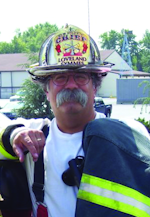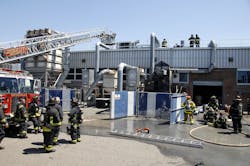Close Calls: Ductwork Falls on Firefighter at Industrial Fire (Part 1)
The Westbury Fire Department (WFD) is located in Nassau County, NY, just outside of New York City on Long Island. Its 150 volunteer firefighters, EMTs and paramedics protect a population of approximately 15,000 residents out of two firehouses as a part of Nassau County’s 9th Battalion. The daytime population from shopping, commercial and industrial is quadruple the base population.
The department responds to approximately 1,800 calls annually, and EMS is a shared responsibility between the WFD and the Nassau County Police Emergency Ambulance Bureau. The WFD, which is well over 100 years old, is overseen by a publicly elected board of Fire & Water Commissioners and lead by a chief of department and assistant chiefs. Captains and lieutenants oversee the three companies: Hose 1, Hose 2 and Hook & Ladder 1 as well as the EMS Squad and the Fire-Police Squad.
Sincere thanks to Chief of Department Doug Ingram and Assistant Chiefs John Bartunek and Ken Gass Jr. for their assistance in sharing the details of this close call. Additional thanks to members of the WFD, the mutual-aid departments and especially Westbury Firefighter Adam Accardi, who suffered significant injuries at this fire.
The incident
On June 22, 2015, Westbury firefighters responded to a known hazardous manufacturing plant for a reported fire. As members were operating, in coordination with the plant’s management and mutual-aid companies, there was a collapse of ductwork, trapping and seriously injuring one firefighter. The collapse was caused due to the ductwork having a significant buildup of materials that got heavier as water was applied and absorbed.
Assistant Chief Gass’ perspective
At approximately 1338 hrs, I was seated in the ready room at Westbury Fire Headquarters eating lunch when the alarm phone rang reporting a structure/roof fire at Oerlikon Metco, 1101 Prospect Ave., in Westbury. This building was immediately familiar to me as a large manufacturing plant and warehouse that has multiple hazardous materials as they are in the business of making airplane parts.
Unfortunately, my chief’s car was out of service for the day so I responded on Engine 966 out of headquarters. As we got to Prospect Avenue, Chief 9601 (Chief of Department Doug Ingram) gave the transmission of a working fire, and as we pulled up, I could see the smoke coming from the rear of the structure as we wrapped the fire hydrant.
The engine pulled to the Bravo side of the building where I met with 9601 who informed me that we had a metal dust collection unit on fire in the rear of the building. I went through the warehouse, which had a decent smoke condition, and got to the rear where I found the unit on fire.
I immediately called for a 2½-inch line and asked for any metal extinguishers that were with us or at the facility. Chief Ingram spoke with a company representative who told him that the metal we were dealing with was cobalt and aluminum and that water would be a safe method for extinguishment.
The 2½-inch line was stretched through the warehouse and was originally operated by Firefighter Christopher Driscoll under my command, with Firefighter Matthew Buck backing him up. We opened up on the unit, which was well involved in fire, and began to knock it down. Lt. Timothy Stewart, who was also on the engine with me, began to open the ductwork on the side of the building to check for extension.
Approximately five minutes into the operation, Westbury Tower Ladder 962 arrived on scene and, led by Lt. Dan Iglesias, went to the roof to open the ductwork to check for extension on the roof. When they opened up the two ducts, they found heavy smoke, heat and some fire. A 2½-inch line was stretched to the roof and operated into the duct by the roof team.
After about 20 minutes of operating at the scene, there was a major collapse of the ductwork connected to the unit that ran to the roof. I screamed to try to warn the nozzle team, but there was not enough time and, due to the noise of the operation, they never heard me.
As the unit collapsed, I was able to push a piece of it away; however, it still fell on Firefighter Accardi who had relieved Firefighter Driscoll on the nozzle. The heavy and hot ductwork pinned Accardi by his left leg and he was screaming in pain. Next to me on the ground was a Halligan tool that I was able to slide under the unit next to his leg.
With the help of a Nassau County Fire Marshal, who was assisting at the scene, and two Hicksville firefighters, we were able to lift the duct off Accardi’s leg and slide him out from under the duct. This happened right after I transmitted an urgent message for the collapse, requesting EMS to the rear.
Upon my transmission, Assistant Chief Bartunek immediately sent the FAST team (rapid intervention) to assist us, and EMS was sent to the rear. Accardi was treated by Medic Sandra Sammartano of the Jericho Fire Department, who was on scene as mutual aid. Accardi’s leg was immobilized, and he was transported by Nassau County police ALS ambulance to the Nassau University Medical Center Trauma Unit in nearby East Meadow. After the incident, we reevaluated our plan, backed up a bit, and continued firefighting operations.
Firefighter Accardi’s perspective
I was at my home when my pager alerted me for a building fire. I responded to Westbury Fire Department Station 2. Firefighters Ken Hessel and Michael Faller arrived, and we responded on Unit 967 knowing that a working fire had been transmitted.
As we arrived in front of the building, we were told by command via radio to secure a hydrant and charge the 5-inch large-diameter hose that was already laid out. After doing so, Firefighter Hessel operated the pump panel. Firefighter Faller and myself made our way to the side/rear of the building where everyone was operating. We relieved Firefighters Driscoll and Buck from the 2½-inch hoseline.
After a small amount of time on the line, we shut down, backed the line up and put it into a loop so it could be operated by one firefighter with ease. I immediately started flowing water again, and the steady stream of water was containing the remaining fire that was left inside the unit.
As I was operating the line I heard a yell and immediately saw a large shadow cast over me with no time to react. A large section of duct had fallen on top of me, pinning both of my legs below the knee. I immediately started screaming for help due to the pain.
Within seconds I had a swarm of firefighters and EMS workers trying to free me from the duct. Assistant Chief Gass then used a Halligan to lift it just enough to remove my legs. As I was dragged backward, I knew that my left leg was broken. After I was removed from the operation, EMS started removing my PPE one piece at a time. They located the injury on my left tibia and placed me on a stretcher to be transported in a Nassau County police ALS ambulance to the trauma center.
In the hospital, my X-rays were seen by the orthopedic surgeon, who confirmed that I had a complete fracture of my left tibia, and he explained to me about having surgery to install a rod with screws to hold it in place. I went into surgery and stayed in the hospital for three nights. I am currently on crutches and taking physical therapy. At this point I am recovering and trying to get back into firefighting shape.
Next month
Next month we’ll look at some additional details from those involved, and offer an overview of the fire as well as lessons learned.

Billy Goldfeder
BILLY GOLDFEDER, EFO, who is a Firehouse contributing editor, has been a firefighter since 1973 and a chief officer since 1982. He is deputy fire chief of the Loveland-Symmes Fire Department in Ohio, which is an ISO Class 1, CPSE and CAAS-accredited department. Goldfeder has served on numerous NFPA and International Association of Fire Chiefs (IAFC) committees. He is on the board of directors of the IAFC Safety, Health and Survival Section and the National Fallen Firefighters Foundation.






